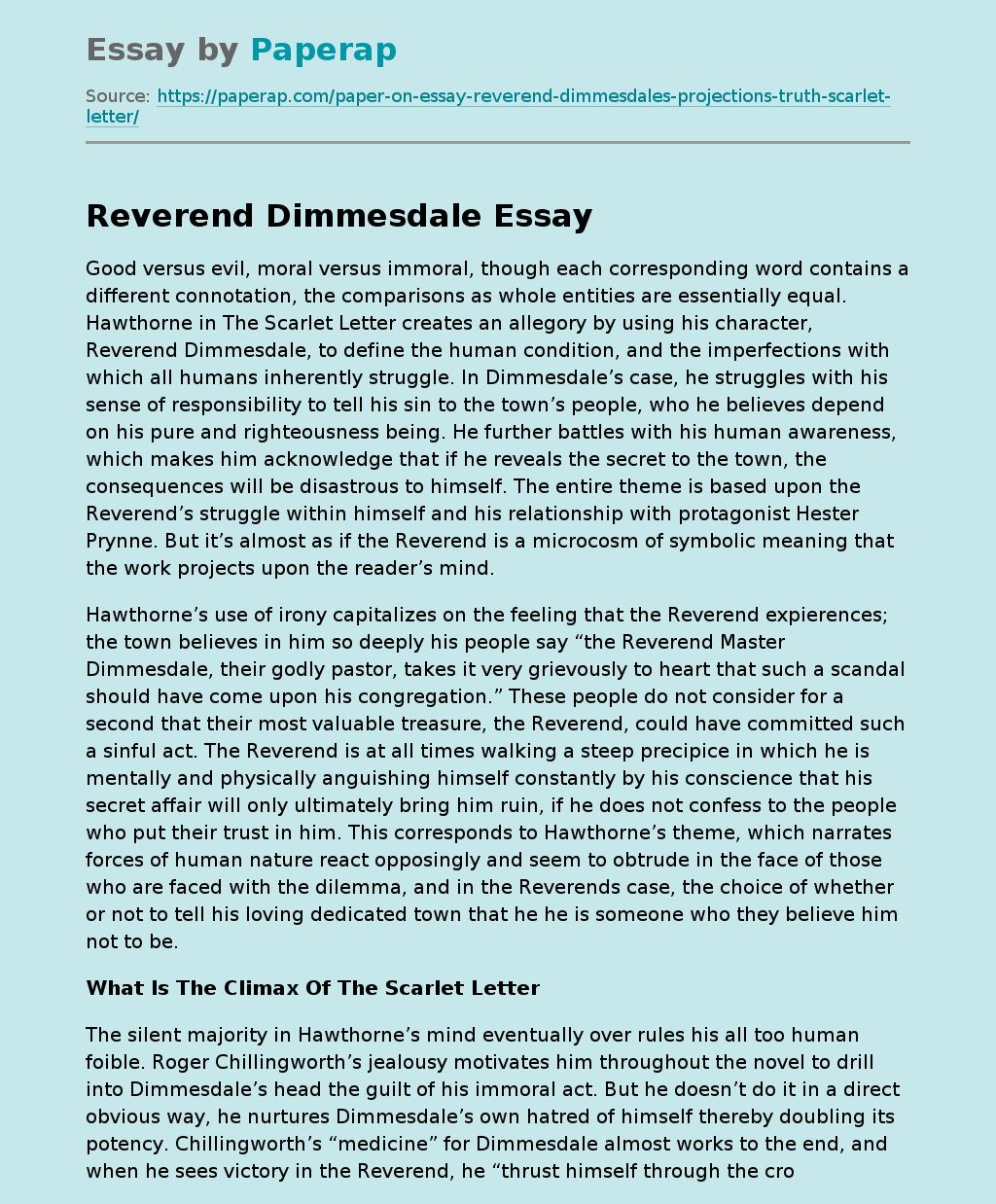Reverend Dimmesdale
Good versus evil, moral versus immoral, though each corresponding word contains a different connotation, the comparisons as whole entities are essentially equal. Hawthorne in The Scarlet Letter creates an allegory by using his character, Reverend Dimmesdale, to define the human condition, and the imperfections with which all humans inherently struggle. In Dimmesdale’s case, he struggles with his sense of responsibility to tell his sin to the town’s people, who he believes depend on his pure and righteousness being. He further battles with his human awareness, which makes him acknowledge that if he reveals the secret to the town, the consequences will be disastrous to himself.
The entire theme is based upon the Reverend’s struggle within himself and his relationship with protagonist Hester Prynne. But it’s almost as if the Reverend is a microcosm of symbolic meaning that the work projects upon the reader’s mind.
Hawthorne’s use of irony capitalizes on the feeling that the Reverend expierences; the town believes in him so deeply his people say “the Reverend Master Dimmesdale, their godly pastor, takes it very grievously to heart that such a scandal should have come upon his congregation.
” These people do not consider for a second that their most valuable treasure, the Reverend, could have committed such a sinful act. The Reverend is at all times walking a steep precipice in which he is mentally and physically anguishing himself constantly by his conscience that his secret affair will only ultimately bring him ruin, if he does not confess to the people who put their trust in him.
This corresponds to Hawthorne’s theme, which narrates forces of human nature react opposingly and seem to obtrude in the face of those who are faced with the dilemma, and in the Reverends case, the choice of whether or not to tell his loving dedicated town that he he is someone who they believe him not to be.
What Is The Climax Of The Scarlet Letter
The silent majority in Hawthorne’s mind eventually over rules his all too human foible. Roger Chillingworth’s jealousy motivates him throughout the novel to drill into Dimmesdale’s head the guilt of his immoral act. But he doesn’t do it in a direct obvious way, he nurtures Dimmesdale’s own hatred of himself thereby doubling its potency. Chillingworth’s “medicine” for Dimmesdale almost works to the end, and when he sees victory in the Reverend, he “thrust himself through the crowd, or, perhaps, so dark, disturbed, and evil, was his look, he rose up out of some nether region, to snatch back his victim from what he sought to do.” But he fails to stop Dimmesdale from relaying the truth to the crowd of people. Chillingworth’s failure to petrify the Reverend in his form of guilt brings his eventual fall, because his only purpose in life has escaped his grasp. The author exemplifies this feeling toward Dimmesdale in Chillingworth in a part of his overriding theme which is the fact that human’s must not focus their attention on one sole aspect in life; there must be a variety. This is also true for Dimmesdale because he focuses only on his fault for a period of time, but as the story comes to a climax, he begins to bring Hester back into his life, and only then does he gain enough courage to testify his secret.
“The elders, the deacons, the motherly dames, were like importance that he should make trial of the physicians frankly offered skill. Mr. Dimmesdale gently repelled their entreaties.” We can clearly see that Dimmesdale’s own people actually helped bring the counterproductive person into the Reverend’s life. This further describes theme of defining the human condition. It not only shows through in the individual, but as a whole unit which then has ironic effects. Thus, we see the Reverend as a representation which is essential in relating the theme to the reader.
Reverend Dimmesdale. (2019, Dec 05). Retrieved from https://paperap.com/paper-on-essay-reverend-dimmesdales-projections-truth-scarlet-letter/

